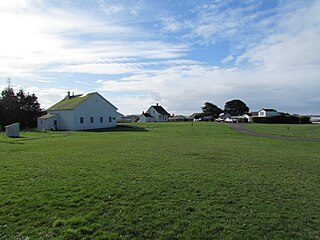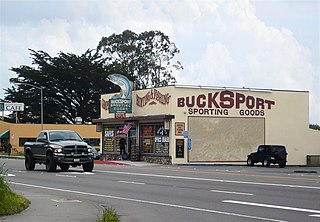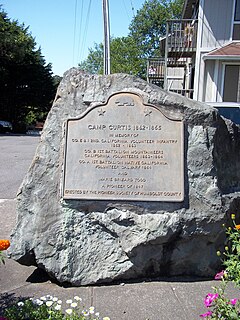Related Research Articles

Camp Lincoln, in Crescent City, California, was a United States military post. It was established June 13, 1862, by the men of Company G, 2nd Regiment, Infantry, California Volunteers to keep peace between the Tolowa tribe of Native Americans and the miners and settlers of northwestern California.

Fort Humboldt State Historic Park is a California state park, located in Eureka, California, United States. Displays interpret the former U.S. Army fort, which was staffed from 1853–1870, the interactions between European Americans and Native Americans in roughly the same period, and both logging equipment and local narrow gauge railroad history of the region. Within the collection, there are trains, logging equipment, including a fully functional Steam Donkey engine, and an authentic Native American dug-out canoe. The Fort overlooks Humboldt Bay from a commanding position atop a bluff. The North Coast regional headquarters of the California State Parks system is located onsite.

California's involvement in the American Civil War included sending gold east to support the war effort, recruiting volunteer combat units to replace regular U.S. Army units sent east, in the area west of the Rocky Mountains, maintaining and building numerous camps and fortifications, suppressing secessionist activity and securing the New Mexico Territory against the Confederacy. The State of California did not send its units east, but many citizens traveled east and joined the Union Army there, some of whom became famous.

Fort Yuma was a fort in California located in Imperial County, across the Colorado River from Yuma, Arizona. It was on the Butterfield Overland Mail route from 1858 until 1861 and was abandoned May 16, 1883, and transferred to the Department of the Interior. The Fort Yuma Indian School and the Saint Thomas Yuma Indian Mission now occupy the site. It is one of the "associated sites" listed as Yuma Crossing and Associated Sites on the National Register of Historic Places in the Yuma Crossing National Heritage Area. In addition, it is registered as California Historical Landmark #806.
During the American Civil War, Army reorganization created the Department of the Pacific on January 15, 1861. On December 12, 1861, the District of Humboldt was created, consisting of the counties of Sonoma, Napa, Mendocino, Trinity, Humboldt, Klamath, and Del Norte in Northern California. The district was headquartered at Fort Humboldt, located on a bluff above the central portion of Humboldt Bay south of Eureka, California, which is now a California State Historic Park located within the City of Eureka. The District's efforts were directed at prosecuting the ongoing Bald Hills War against the Indians in the northern, coastal area of the large district. A peace was achieved in August 1864.

Bucksport was a town in Humboldt County, California. The original location was 2.5 miles (4 km) southwest of downtown Eureka, on Humboldt Bay about 5 miles (8 km) northeast of entrance. at an elevation of 16 feet (4.9 m). Prior to American settlement a Wiyot village named Kucuwalik stood here.

Crannell is a former settlement in Humboldt County, California. It is located 4.5 miles (7.2 km) southeast of Trinidad, at an elevation of 203 feet (62 m).

Fort Seward is an unincorporated community in Humboldt County, California. It is located on the Eel River 3.5 miles (5.6 km) north-northwest of Alderpoint, at an elevation of 328 feet.
Humboldt City is a former settlement in Humboldt County, California. It was located on Humboldt Bay just south of the later site of Bucksport. The townsite was laid out in 1850 but was nearly deserted by 1851.

Iaqua is a former settlement in Humboldt County, California. It was located 5.5 miles (8.9 km) south of Kneeland.

Fort Gaston was founded on December 4, 1859, in the redwood forests of the Hoopa Valley, in Northern California, on the west bank of the Trinity River, 14 miles (23 km) from where the Trinity flows into the Klamath River. It was located in what is now the Hoopa Valley Indian Reservation. Fort Gaston as part of the Humboldt Military District was intended to control the Hupa Indians and to protect them from hostile white settlers. The post was named for 2nd Lieutenant William Gaston, of the First Dragoons, who had been killed May 17, 1858, during the Spokane–Coeur d'Alene–Paloos War.

The 2nd Regiment California Volunteer Infantry was an infantry regiment in the Union Army during the American Civil War. It spent its entire term of service in the western United States. Organized at San Francisco and Carson City September 2, 1861, to December 30, 1862, and attached to Department of the Pacific. The regiment was first assembled at the Presidio, San Francisco, and after completing its organization, five companies were sent to Oregon and Washington Territory, to relieve the regular troops, and two companies were sent to Santa Barbara. The troops of this regiment sent to Oregon were afterwards returned to California. It was mustered out during the month of October, 1864.
The District of California was a Union Army command department formed during the American Civil War. The district was part of the Department of the Pacific, the commander of the department also being District commander. The district was created as a separate command on July 1, 1864, after Irvin McDowell took command of the Department of the Pacific, relieving General Wright, who then remained as District of California commander. The District comprised the state of California and the areas of the Rogue River and Umpqua River in Southern Oregon. Its headquarters were in San Francisco, co-located with those of the Department of the Pacific. On March 14, 1865, the District of Oregon was extended to include the entire state of Oregon, removing the Rogue River and Umpqua River areas from the District.

1st Battalion California Volunteer Mountaineers was an infantry battalion in the Union Army during the American Civil War. It spent its entire term of service in the western United States, attached to the Department of the Pacific. It was organized from men from the counties of Humboldt, Mendocino, Trinity, Klamath, Siskiyou, and Del Norte, and other parts of California, between May 30, 1863, and March 16, 1864, for special service in the redwood forests and mountains that was being fought over in the Bald Hills War in Humboldt County within the Humboldt Military District. The Battalion mustered out June 14, 1865.
Elk Camp was an American settlement between Redwood Creek and the Klamath River, fifteen miles northwest of Fort Anderson in modern Humboldt County, California it was formerly located in Klamath County. Elk Camp was a post office from January 31, 1859 to December 19, 1862.
Francis J. Lippitt (1812–1902) was an American lawyer and veteran of the Mexican–American War, the Bald Hills War and the American Civil War. For the later he was made a brevet brigadier general.
Camp Bidwell, later Camp Chico, was a U.S. Army post during the American Civil War. Camp Bidwell was named for John Bidwell, the founder of the nearby town of Chico, California and a Brigadier General of the California Militia. It was established a mile outside Chico, by Lt. Col. Ambrose E. Hooker with Company A, 6th California Infantry, on August 26, 1863. Although a Company F, 2nd California Cavalry and Company K, 2nd California Infantry under Captain Augustus W. Starr had been there from July 31, 1863, Lt. Col. Hooker moved the camp to a new location for its better defense and for better sanitation.
Daley's Ferry Post was a California Volunteer post at the Daley's Ferry crossing of the Mad River nearly three miles from the town of Arcata in Humboldt County. It was established by the following order to Captain E. B. Gibbs, Company E, 2nd California Infantry Regiment at Camp Curtis likely in response to an attack on the Ferry in June 1862:
Headquarters Humboldt Military District,
Fort Humboldt, June 8, 1862.
Major: I have the honor to report that on the 6th instant, at 4 p. m., the house or hotel at Daley's Ferry, on Mad River, about five miles from Arcata, and on the most constantly traveled trail, was attacked by a band of Indians, some fifty or sixty in number, all well armed with rifles and shotguns. There were but two soldiers stationed there, as the owner deemed it hardly necessary to have any guard so near to town, and on a public highway. The Indians opened the attack by a volley from the brush. Private Bacon was wounded in the groin at the first fire, but he and his comrade, Private Wyatt, rushed to the house and commenced firing from the windows. Daley also ran to the house, but leaving his family behind, he seized his rifle and fled to his boat in the river. Our soldiers, thus left alone, directed the women and children to endeavor to reach the boat, and they would remain and keep the Indians at bay. The family were successful in making good their escape to the boat, when our men, keeping up their fire, retired slowly, both being now wounded and faint from the loss of blood. Wyatt only was able to reach the boat. Bacon concealed himself behind a log in the brush, and from that position saw and counted twenty-seven Indians who entered the house, pillaged and set it on fire. The party in the boat were immediately fired upon by about twenty Indians on the opposite bank. An old lady, mother of Mrs. Daley, was struck by three balls and killed. Mrs. Daley was wounded in the arm, and Private Wyatt was again wounded, an dint he arm under the shoulder, the ball grazing his breast, he being in the act of firing. His first wound was in the groin, and similar to that of Bacon. They were then forced to put back to the shore, escaping into the brush. Mrs. Daley struggling along with two children at last fell from exhaustion, upon which her husband cowardly abandoned her, throwing his infant that was in his arms into the bushes and making for Arcata. Some Indians came up to Mrs. Daley, robbed her of her rigns and pursue, and said they would not "kill white squaw. " The brave woman made another effort and walked some distance; then taking off off some of her clothing wrapped it around the two eldest, hid them in the bushes and kept on, carrying her infant in her arms, one of which was torn open from the elbow to the wrist by a rifle bullet. She was rescued at last by people from Arcata who came out for the purpose, and who by her directions found the children calmly sleeping at about 2 a. m. Our wounded men were also found, and are now in the hospital at this post, their wounds, though severe, not proving dangerous. I hired man is missing and supposed to be killed, and the Indians carried off a nephew of Mrs. Daley, about five years old. I beg leave most respectfully to bring to the notice of the general commanding Private Joseph N. Bacon, Company I, and Private Henry H. Wyatt, Company H, Second Infantry California Volunteers, for admirable coolness and braver under the most trying circumstances. I omitted to mention that the soldiers finding themselves disabled put their arms out of the reach of the Indians, one hiding his musket in the brush the other throwing his piece into the stream.
I have the honor to be, most respectfully, your obedient servant,
Jas. N. Olney,
Lieutenant Colonel Second Infty. Colonel Vols., Commanding Humboldt Mil. Dist.
Major R. C. Drum, U. S. Army,
Assistant Adjutant-General, Sant Francisco.:
Special Orders, No. 4.} Hdqrs. Humboldt Military District, Fort Rumboldt, January 6, 1863.I. Captain Gibbs, commanding at Camp Curtis, will put a detachment of twenty men under Lieutenant Gonnisson at Daley's Ferry, as soon as he is notified that Mr. Daley is ready to proceed thither.
II. Lieutenant Gonnisson will guard the ferry and ferry-house from attack, and will use every exertion to capture or destroy every band of hostile Indians that may come into his neighborhood, leaving always a sufficient force at the ferry for its defense.
III. In case of need Captain Gibbs will re-enforce Lieutenant Gonnisson to any extent that may be requisite. lie will forward Lieutenant Gonnisson's reports of scouts or military operations to these headquarters.
By order of Colonel Lippitt:
W. F. Swasey,
First Lieutenant and Regimental Quartermaster Second Infantry California Volunteers, Actg. Asst. Adjt. Gen.

Camp Curtis, California State Historic Landmark #215, was located about one mile north of Arcata, California, and served as the headquarters and garrison of the 1st Battalion California Volunteer Mountaineers from 1862 to 1865.

Fort Baker, in Humboldt County, California was an outpost of the Union Army for the Bald Hills War from 1862 to 1863. It was located 14 miles (23 km) east of Bridgeville on State Highway 36 on the west bank of Van Duzen Creek in Larabee Valley. The site of Fort Baker has been obliterated by frequent flooding.
References
- 1 2 3 Durham, David L. (1998). California's Geographic Names: A Gazetteer of Historic and Modern Names of the State. Clovis, Calif.: Word Dancer Press. p. 29. ISBN 1-884995-14-4.
- ↑ The California State Military Museum, Historic, California Posts: Camp Lippitt
| | This Humboldt County, California–related article is a stub. You can help Wikipedia by expanding it. |
